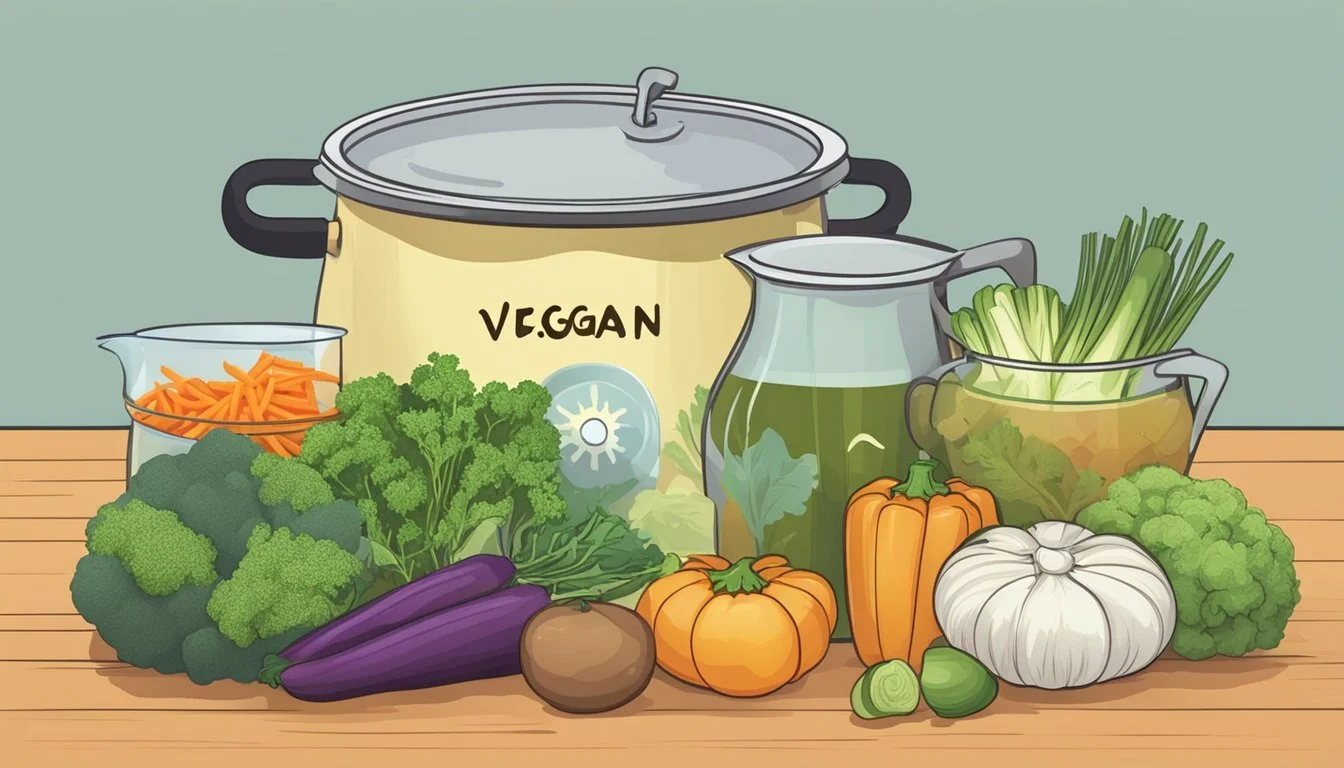Is Vegetable Broth Vegan?
Unveiling the Truth About Plant-Based Broths
Vegetable broth is a flavorful liquid made by simmering vegetables, and sometimes herbs and spices, in water. As its name suggests, it typically contains no animal products, which makes it an inherently vegan-friendly option for a variety of culinary uses. The versatility of vegetable broth extends beyond being a base for soups and stews; it can also be used to add depth to sauces, cook grains, and sauté vegetables, enhancing the overall flavor profile of vegan dishes.
The process of making vegetable broth involves a medley of vegetables such as onions, garlic, carrots, and celery, often accompanied by ingredients like tomatoes, parsley, and thyme to create a rich, savory liquid. Homemade recipes allow for complete control over the contents, ensuring the absence of animal derivatives or unwanted additives which might concern those following a strict vegan diet. Store-bought options are widely available as well, with many brands providing vegan-certified broths to cater to the growing plant-based community.
For individuals adopting veganism, whether for health, ethical, or environmental reasons, understanding the components of their food is crucial. Vegetable broth stands out as a simple yet foundational element in vegan cuisine, providing cooks with a tool to infuse dishes with moisture and flavor without compromising on their dietary principles. Despite its simplicity, it remains a largely indispensable ingredient in the vegan kitchen.
Essential Attributes of Vegetable Broth
Vegetable broth, a fundamental component of many vegan cuisines, is a flavorful liquid made by simmering vegetables in water. This section explores the vegan composition of this broth, the common ingredients and possible variations one might encounter, and the nutritional aspects that make it a beneficial part of a vegan diet.
Vegan Composition of Broth
Vegetable broth is inherently vegan, consisting primarily of water and an assortment of vegetables. Vegan broth is free of animal products, making it suitable for individuals following a vegan lifestyle. The key to ensuring the broth remains vegan lies in avoiding the use of any animal-derived ingredients during preparation, such as bones or meat found in traditional non-vegan broths.
Key Ingredients and Variations
The foundation of vegetable broth typically includes a mirepoix blend of carrots, celery, and onion, which provides a base flavor. Herbs such as parsley, thyme, and bay leaves contribute to the broth's aromatic profile, while garlic, pepper, and optionally, turmeric, add depth and complexity. Additional vegetables and flavor enhancers include:
Aromatic vegetables: leek, onion skins, and carrot tops
Umami-rich ingredients: kombu seaweed, shiitake mushrooms, and nutritional yeast
Additional herbs and spices: rosemary, bay leaf, and peppercorns
Some variations may also include ginger for heat or dried mushrooms for a more earthy flavor. It's common to see parsnip in the mix for a hint of sweetness.
Nutritional Profile
While vegetable broth is not a significant source of protein, it can be rich in essential nutrients like calcium, potassium, and various vitamins, depending on the vegetables used. Its sodium content varies — homemade broths can be made with little to no salt, catering to those seeking a low-sodium option. Here is a simple nutritional breakdown for a standard cup of vegetable broth (values can vary):
Nutrient Approximate Amount Calories 15-30 kcal Sodium 200-900 mg Potassium 70-300 mg Calcium 10-30 mg Protein 0-2 g
These values highlight vegetable broth as a low-calorie, potentially low-sodium addition to meals, with variable minerals depending on the specific vegetables and seasonings used.
Culinary Applications
Vegetable broth is a fundamental ingredient in vegan cooking, offering a rich flavor profile to a wide array of dishes. Its applications range from simple soups to complex main dishes.
Soups and Stews
Vegetable broth serves as the liquid base in vegan soups and stews, providing depth and enhancing the overall taste. A robust broth can elevate a simple vegetable soup and is crucial for heartier recipes like vegan chili. In Asian cuisine, vegetable broth is indispensable in dishes like pho and ramen, where it's simmered with spices and herbs to create a flavorful, aromatic foundation.
Pho: Simmer broth with star anise, cloves, cinnamon, and cardamom.
Chili: Use as a cooking liquid to meld spices and vegetable flavors.
Sauces and Seasonings
Broth isn't just for soups; it's also integral in preparing sauces and seasonings. It can be reduced to form the base of a rich, savory sauce or used as a liquid for making gravy. In vegan cooking, it's a healthful substitute for stocks that may contain animal products, ensuring that no flavor is lost in plant-based sauces.
Gravy: Thicken broth with flour or starch; season with herbs.
Sauces: Deglaze pans with broth to capture the essence of sautéed vegetables.
Main Dishes Incorporating Broth
Incorporating vegetable broth into main dishes such as risotto or quinoa imparts moisture and a complex flavor. It enhances grains and legumes by infusing them with its essence during the cooking process—like simmering quinoa in broth until it's fluffy and aromatic.
Risotto: Cook slowly with broth, stirring frequently for creaminess.
Quinoa: Replace water with broth to infuse the grain with a savory character.
Preparation Techniques
When creating homemade vegetable broth, the selection of fresh ingredients and the methods of simmering and straining are critical. The resulting broth's quality can be preserved effectively with appropriate storage techniques.
Steps to Making Homemade Broth
A typical process for making homemade vegan broth begins with the gathering of a variety of fresh vegetables and herbs. One can opt for olive oil or avocado oil to lightly sauté the vegetables before covering them with filtered water. This creates a rich base of flavors. The mixture is then brought to a boil before reducing the heat to a simmer for 60 to 90 minutes, allowing the flavors to meld together. After the simmering process, the broth is strained through a fine mesh colander to remove the solids, resulting in a clear and flavorful liquid.
Storing and Preserving Broth
Once the homemade vegetable broth is prepared, it can be utilized immediately, or one can store it for future use. To keep the broth, one may refrigerate it, where it will typically remain fresh for up to 2 weeks. For longer storage periods, pouring the broth into freezer-safe containers and freezing it is highly recommended. Frozen broth can last for about 6 months. Always label the containers with the date to track the freshness of the broth.
Health and Dietary Considerations
When considering vegetable broth from a health and dietary standpoint, it is essential to assess nutrient content and suitability for those with certain dietary restrictions or health goals.
Low-Sodium and Allergy-Friendly Options
Vegetable broth can be an excellent option for individuals monitoring their sodium intake. Many store-bought broths are high in sodium, which can be a concern for those with hypertension or cardiovascular issues. However, brands may offer low-sodium versions, and homemade broths can be tailored to contain minimal salt. Furthermore, for those with allergies, vegetable broth often presents a safe choice as it can be made without common allergens such as gluten, nuts, and dairy.
Bone Broth vs. Vegan Broth Comparisons
Comparing bone broth and vegan broth unveils distinct health implications. Bone broth is praised for its protein content and is a source of collagen, which proponents claim benefits skin, hair, and joint health. Vegan broth, often known as "vegan bone broth," does not actually contain bones but aims to mimic the savory flavor profile using plant-based ingredients. It generally lacks collagen due to the absence of animal products but can still be a healthy option, potentially containing various nutrients from the array of vegetables used. Vegan broths are often lower in calories and can be made oil-free, appealing to those who prefer less processed fats, like coconut oil, in their diets.
Shopping and Product Selection
When opting for vegan vegetable broth, consumers should focus on whether the broth is pre-made or made from scratch and the quality of ingredients used. Understanding the product labels and ingredients list is crucial for maintaining a vegan diet.
Buying Pre-Made Broth
Shoppers can find a variety of vegan broth options at their local grocery store. Brands like Trader Joe's, Kitchen Basics, and Imagine Organic offer vegetable broths that are explicitly labeled as vegan. It is important to check for a vegan label, as some broths may contain animal-derived preservatives or flavorings.
Look for labels: Products should clearly state "vegan" or "plant-based."
Check for preservatives: Avoid broths with animal-derived preservatives.
Selecting Quality Ingredients
For those who prefer to make their own broth, selecting high-quality, fresh ingredients is vital. A rich, flavorful broth often includes a variety of vegetables, such as carrots, onions, and potatoes. Adding miso, seaweed, and shiitake mushrooms can enhance the umami flavor without animal products. Coconut oil can be used as a base for sautéing vegetables, and fresh thyme adds a layer of depth to the aroma. Using a mix of these ingredients ensures not just a vegan-friendly option, but one that is also rich in nutrients.
Aromatic Foundation:
Carrots, onions, celery
Fresh herbs like thyme and bay leaves
Umami Boosters:
Miso paste, seaweed, shiitake mushrooms
Oil Choice:
Opt for coconut oil or other plant-based oils.
In conclusion, by carefully examining labels when buying pre-made broths and selecting high-quality, fresh ingredients for homemade broth, consumers can enjoy flavorful, vegan vegetable broths that comply with their dietary preferences.
Community Engagement and Feedback
Vegetable broth, a staple in vegan cooking, receives considerable attention on social platforms and rating systems. Users frequently engage with others by sharing their experiences, adjustments, and preferences, leading to a rich tapestry of community interaction.
Sharing Recipes on Social Platforms
The vast vegan community on Instagram consistently shares vegetable broth recipes. Alongside original posts, users commonly comment to offer tweaks that enhance the broth's flavor, such as the addition of lemon for zest or cilantro for a fresh note. They also suggest substitutes like miso paste to impart umami instead of traditional non-vegan chicken stock. Each shared post becomes a collaborative space where followers can learn and improve their vegan broth-making techniques.
Reviewing and Rating Broths
Consumer feedback and star ratings play a crucial role in signaling the quality of store-bought vegetable broths. Savory recipes that call for broth often feature recommendations for specific brands, bolstered by community ratings. It is not uncommon for products to be critiqued on sugar content, clarity of labeling, and overall taste. These reviews act as a guide for others seeking the best vegan broth options and influence purchasing decisions in a tangible way.





